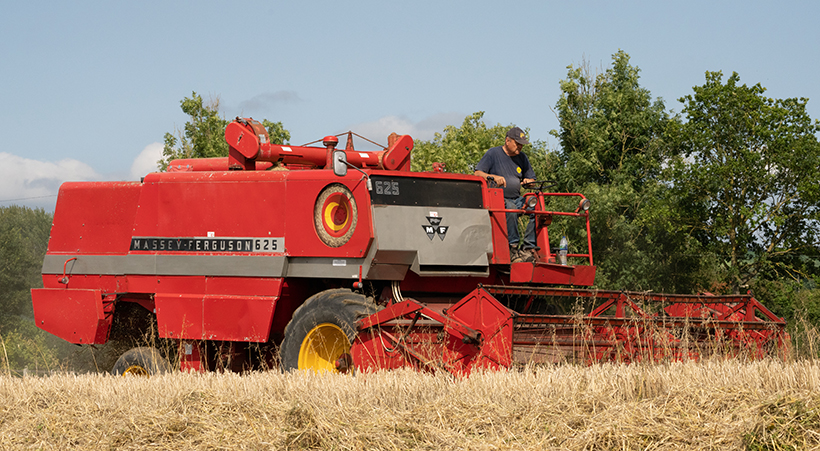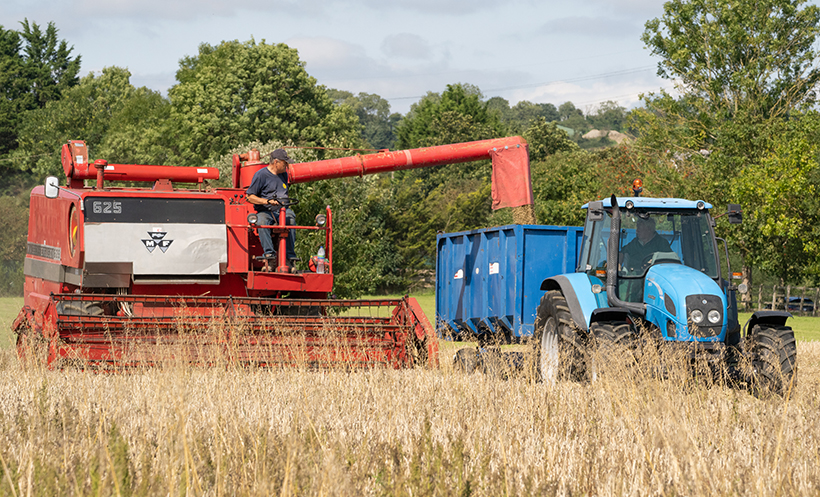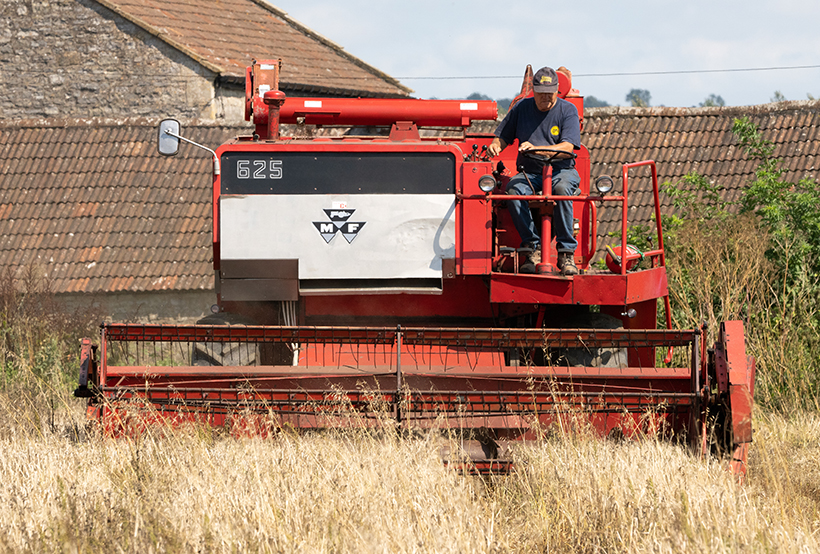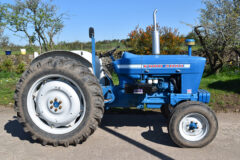1972 Massey Ferguson 625 combine harvester works again
Posted by Chris Graham on 8th November 2023
Scott Lambert chats to Somerset’s Colin Cloude about his latest rescue mission, a 1972 Massey Ferguson 625 combine harvester.

Colin Cloude with his 1972 Massey Ferguson 625 in a crop of spring barley.
Those of you that are passionate about Massey Ferguson combine harvesters, and particularly those of you that use Facebook, will be familiar with Colin Cloude. He has been collecting and using these machines for several decades, and over the years he has saved many iconic models.
He started with an early 780, but went on to own 400, 410, 515, 525, Canadian-built 750 and 860 models, and, last year, a Dronningborg-built MF 36RS. Many of these machines would have met a sad end if it was not for Colin, but there comes a point when you to have take stock of the situation and decide what’s best.
“At the age of 65, I decided to scale back the collecting, after what seemed like another combine coming in every year that required much attention, after sitting parked up for many years in various sheds!” Colin explained.
“It’s been a similar story so many times – someone would get in touch and say there’s a certain model they know of that’s been parked up. The owner’s usually deceased and the younger family members, not having any attachment to the machine, are glad usually to just get rid of these things of vintage history!
“I wasn’t looking for another project this year, to be honest, but in early May this 625 flagged-up on my radar. It was coming up for auction in Suffolk at a Clarke & Simpson dispersal sale! I had one photograph to go on, but it just captured my attention as I could see that it was one of the first models, and I know the rarity of those early ones now.
“I got in touch with the auctioneer and ended up with about 60 photos – which was enough to see me register for bidding! Against my better judgement I decided not to go and view the combine. It is what it is, and I could see that it had had a good owner! Everything about it was looking favourable for a light restoration!” Colin joked.

A good sample is produced, with the grain tank able to hold 87 bushels (3,165 litres).
“To be honest, mechanically there could have been serious issues. Broken straw walkers, a broken shaker shoe, or 100 other possible scenarios, but I just had that feeling that she was right.
“I was given the contact number of the haulier that picked her up from the farm and he told me that it started OK but that the water pump was seized, so it was removed. The owner had died, and it was said that he had owned it from new, along with many other pieces of classic MF kit – 500 Series tractors and Weeks-built MF trailers. They were all in good condition but had not been used for many years, and it was estimated that the combine had stood idle for 17 years.”
This didn’t put Colin off, as he had taken on challenges like this before, and he decided to bid on the 625, with the aim of resurrecting it and putting it to work. His 36RS had been a labour of love, with the challenges of electronic controls, but he managed to get it working well in time for last year’s harvest – only for it to meet an untimely end when it succumbed to the ravages of fire.
Despite a modest acreage, there was a need for a competent combine, so Colin decided to take a punt on the 625 – providing he could secure it at a sensible price.
Realistic
“On the last day of auction, I watched the bidding and it struggled to get to £950,” Colin said. “I knew at that point that it was going for scrap, but I was at a disadvantage as I had to factor in a £700 haulage bill. I needed to be realistic, so I set a limit of £1,000!
“I was genuinely worried that this old maiden was going to meet her fate, which would be such a tragedy after the care the previous owner had spent on keeping this 52-year-old combine in good shape! Anyway, I bid online during the last few seconds of the auction and after 20 minutes I was informed that I had secured the lot.

Colin puts the combine’s appearance down to hard work and Zvizzer HC 4000 Heavy Cut compound!
“I then had the realisation that I was in for those long evenings and weekends trying to get her in harvest shape for this season! Time was not on my side, as it took nearly a month to get her home!”
Anyone that has knowledge of combines will appreciate that there’s a lot to check before putting a machine to work, but before looking at any of the internals there was the small matter of the water pump to attend to. Colin had been told that the water pump had been secured to the seat, but it wasn’t there – and neither was the all-important adaptor plate.
“The next few weeks I was on a quest to source not only a pump, but the adaptor spacer plate it fits to,” explained Colin. “This engine is the Perkins A6.372 – which is essentially a 6.354 bored out to give more power – 118hp to be exact! Sadly, many parts for this engine are now obsolete, so I was in a conundrum.
“After a call for help on social media, I received many calls and messages. One of them gave me a contact in Poland that had brand-new pumps for sale. They had a six-stud mounting and two outlets, for £86 plus postage. So, after getting over the language barrier, I ordered a pump.
“It arrived 10 days later, but only had a single outlet. I needed a dual outlet, and it turned out that there wasn’t one available – so I was back to square one. In the meantime, I concentrated on everything else I could do without running the engine – with plenty of time to concentrate on tidying up the paintwork with my magic formula.
“I spent many hours on the panels using a wonder product called Zvizzer HC 4000 Heavy Cut! It really is the best compound I’ve ever used for paintwork, and I’ve tried them all! It’s very expensive, but worth every penny, and it’s not harsh on the paint either.”

This combine was supplied with a 14ft table, but 12ft and 16ft tables were also available.
As June moved into July, Colin seriously contemplated getting one of his other combines out of the shed and leaving the 625 for the harvest of 2024. The hope of getting the water pump and adaptor plate was looking remote, so it might just be that fate wasn’t on his side on this occasion.
Luckily, just as Colin was about to admit defeat, he received a message from a gentleman in Suffolk who informed him that he could supply not only an adaptor plate, but a pump too! He had removed it from an MF 1200 tractor many years ago and had kept it in his workshop! “That man saved the day; I can tell you!” Colin exclaimed. “Without him this would not have worked this year!
“Overall, the combine was okay, but just stiff everywhere! Most things were seized! The list is endless and it’s quite easy to get intimidated by it, but if you have a plan and a list in your mind it can be a lot easier!
“The usual high work rate belts needed replacing – the returns, the walkers, the Multi-Flow, the hydraulic pump drive, and the table drive. The only belt I had to buy was the Multi-Flow, as the others I had in stock – albeit some second-hand!”
Common issues
Colin continued: “Just one bearing was replaced, and the drive chains were removed, brushed, cleaned, and soaked in oil and diesel for two weeks! All the gear oils were changed, plus the oil in the wobble box.
“The rear sieves had received welding repairs in past, but this is a common issue with early 625s as they have a three-deck triple sieve shoe that tends to shake to pieces! Also, the fanning mill has received strengthening – but this is another known issue.
“With a little over two weeks before harvest, my good friend Hillary and I had everything needed to put her back running, apart from settled weather! I kept her outside, as my shed is very dark, and it was quite tight to move around the combine.
“The last few jobs were changing the engine oil and fitting a later-type filter head to take the spin-on filters, changing the fuel filters, cleaning the fuel tank sediment bowl, removing and cleaning the fuel lift pump, and replacing the water temperature gauge.”

The MF 625 was supplied by the Oliver Rix Group, which had branches across Norfolk and Suffolk.
With the combine ready to go, all that was left to do was give the table a once-over. It mainly required some TLC, but the fore and aft adjustment for the pick-up reel was non-existent. It was seized solid and took Colin and Hillary many hours to get it moving as it should.
“The one thing that I was reminded of is that after more than a decade of inactivity, a combine takes on a distinctive smell,” Colin said. “When all the plant matter has rotted away, they have a musty smell. Everyone I’ve done has smelled the same! If a combine cut a crop four or five years ago, you still get that harvest smell.
“With a few days until harvest, I had her running for around 45 minutes, carefully monitoring everything! And that’s all you can do! Cutting crops is another thing altogether, and that’s even with my experience with these machines!
“I’m usually apprehensive for a few trips around the first field, but I needn’t have worried. I had 12 acres of spring barley to cut and the 625 completed the field without a major problem! There were the usual feeding issues, caused by corrosion throughout the combine, and as the barley is a soft straw-type crop it takes a while to shine up the metal surfaces.
“After a couple of hours, the crop flows through lovely and the result is a very contented owner, as well as a great sample in the tank!
“The reward for me is going out and cutting my crops with combines that I spent my younger days on – it brings back very happy memories! Plus, saving what is a rare, early 625 is a bonus. What I know from the serial number is that it was built early in 1972, but the front wheels were made in 1968, as they have a date stamp on them!”
The Massey Ferguson 625 may have only cut 12 acres this year, but it has been saved from an uncertain future by someone that’s passionate about preserving these machines for the next generations to enjoy.
After the harvest went so well Colin has plans to double the acreage for 2024, so there’ll be plenty to go at for the Kilmarnock-built 50-something!
This feature comes from a recent issue of Tractor & Machinery, and you can get a money-saving subscription to this magazine simply by clicking HERE

Previous Post
Very rare 1979 Dodge 300S now in safe hands

Next Post
The very collectable Ford Force 4000



